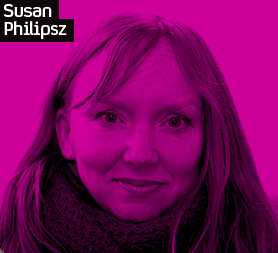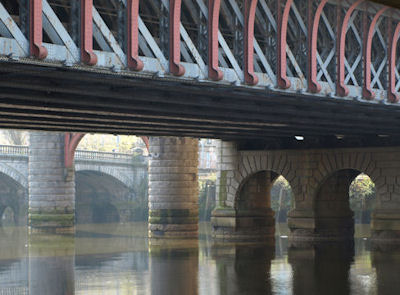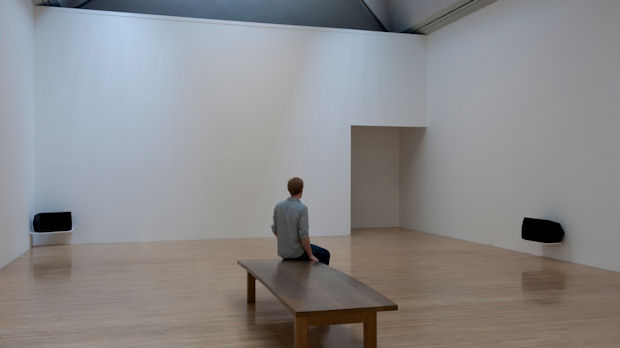Turner Prize 10: Susan Philipsz
Susan Philipsz creates sound installations with her own voice, exploring the psychological effects of song. Her work Lowlands was first exhibited under bridges along the River Clyde in Glasgow.

Susan Philipsz has been nominated for Turner Prize 10 for her work Lowlands at the Glasgow International Festival and her presentation of Long Gone in a group exhibition, Mirrors, at Museo de Arte Contemporanea de Vigo in Spain.
Philipsz uses her own voice to create sound installations that play upon and extend “the poetics of specific often out of the way spaces.”
Born in Glasgow in 1965, in the late 1980s and early nineties she studied at Duncan of Jordanstone College of Art, Dundee, and the University of Ulster. She now lives and works in Berlin, Germany.
Her installations explore the way sound and space connect and define one another. She examines the capacity of the human voice to be both an internal and external force, in the case of Lowlands via the secretive yet public walkways under three bridges along the River Clyde in Glasgow.
3 Minute Wonder on Channel 4 until 9 December (Courtesy: Tate Media)
For previous projects she has used stairwells, supermarkets and promenades as locations for soundscapes, allowing the history and mood of the sites to bleed into the work.
She explained: “When projecting my voice I became conscious of filling the room with sound and this led to thinking about architecture and how sound could define space and how sometimes the space could change the sound.”
‘I’m drowned in the lowland seas,’ he said, Lowlands, lowlands, away my John, ‘Oh, you an’ I will ne’er be wed,’ My lowlands away
Themes of longing and escapism are recurring motifs in Philipsz’s work and these emotions are dominant in Lowlands 2008/2010. The three-channel sound installation features three versions of 16th century Scottish lament Lowlands Away.
Each rendition of the ballad tells the story of a drowned sailor returning to a lover as a ghost to mourn the loss of their time together. Philipsz weaves the songs together, at first running the three tracks simultaneously before gradually overlapping them to create fractured intertwining narratives which come together before diverging again.
More on Susan Philipsz from Turner Prize 10

‘Putting something quite private into a very public context’
“It’s a really old song from the 16th century, it’s an old Scottish lament and it’s about a sailor who drowns who comes back to say a final farewell to his loved one.
“I discovered that there are three different versions of this song. I’ve recorded myself singing all three versions and had them played simultaneously under each of the three bridges that cross the Clyde.
“I always liked the bridges, and the Clyde has always had its own stories. I think from above it looks really magnificent but below it’s darker and more atmospheric. I see it more as the dark underbelly of Glasgow, if you like.
“I’m really interested in song – the emotive and the psychological effects of song. I think when people hear a voice singing unaccompanied, an untrained voice in a public context, it’s quite strange.
“It’s like putting something quite private into a very public context.”

(Lowlands 2008/2010 at Tate Britain. Courtesy: Tanya Bonakdar Gallery, New York, Isabella Bortolozzi Galerie, Berlin. Photo: Tate Photography)
'It is a surprisingly intimate experience,' writes Matthew Cain
Susan Philipsz's work is possibly the most impactful on this year's list as it represents the first time an artist sculpting in sound has been nominated for the Turner Prize.
And in an age in which the British public is much more ready to accept contemporary art in all its forms, it confronts us with yet another possibility. And this new form may seem instantly familiar to us but in the world of the visual arts, it still isn't the case.
When people hear that a sound artist has made the list they often ask me, 'What's the difference between this and just listening to music?'
Well this is a question that no-one who's experienced the work of Susan Philipsz would ever ask. Lowlands is beautifully melancholic and lingers in the mind long after you've left the gallery.
Because the artist's voice is untrained, listening to it in a public setting is a surprisingly intimate experience and produces a tension between the public and the private. In the context of the gallery, it makes you more aware of the space that you're in and, interestingly, more aware of your own body and ultimately, your own self.
It's important to note here that all the work nominated for the Turner Prize was chosen when it was exhibited in another location. The work is then adapted for the Tate Britain show so that a wider public can see why the Turner judges first spotted it.
This point is particularly pertinent in the case of Susan Philipsz as Lowlands was created specifically for public spaces under the bridges of the River Clyde in Glasgow. Listening to the work in a location like this produces a very different effect than listening to it in a gallery.
And it's this very relationship between the sound sculpture and the space within which it's installed that is at the heart of Philipsz's work.
So if you'd like to check out more of her work in exterior locations, catch the series currently on show around the City of London in association with Artangel.